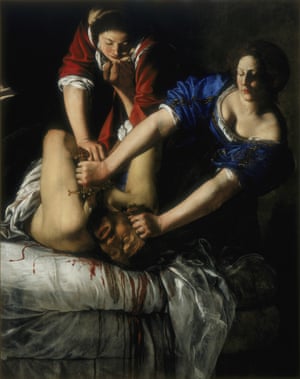Stand By Me has finished echoing through St George’s Chapel, the radical sermon is forgotten and the royal family are back to looking up at flypasts and waving. Did it all mean anything?
I’ve got a simple, cheap and painless way for the monarchy to prove it is serious about all those nice new vibes. It is to give up a single painting from the Royal Collection. This painting has so much relevance to the modern world that it needs urgently to be placed in the National Gallery so it can provide inspiration, right old wrongs and shatter history’s glass ceiling.
The masterpiece in question is Artemisia Gentileschi’s Self-Portrait as the Allegory of Painting. It is something almost unique: a self-portrait by a woman who painted her way to fame 400 years ago. Gentileschi was born in Rome in 1593, into a world of rigid gender hierarchy enforced through violence. Her father was the realist painter Orazio Gentileschi, a close friend of Caravaggio. That gave her access to artistic training, but in 1612 Orazio accused her teacher Agostino Tassi of raping his daughter. At the subsequent trial, Artemisia was treated like a criminal, insulted and shamed, subjected not only to psychological but also to physical torture.
“It is true, it is true, it is true, it is true,” she courageously stated over and over as ropes were pulled tight around her fingers in a torture called the sibille. Now these words have inspired It’s True, It’s True, It’s True, a new play by Breach Theatre Company that premieres at the Edinburgh fringe this summer. After I told Artemisia Gentileschi’s shocking story in the Guardian, this acclaimed company sought out the verbatim transcript of the 1612 trial and have dramatised it with an all-female cast.
If proof were needed that Gentileschi can speak to us today, here it is. And this is why the Royal Collection can do something of huge social value by donating this extraordinary painting to the National Gallery, where it will be seen in a public space in the heart of London, alongside such “Old Masters” as Rembrandt and Caravaggio, not to mention Artemisia’s dad. Why should his work, and not that of his more exciting daughter, be in this museum?
Gentileschi did not let the humiliation of the trial destroy her, even though it ended with Tassi – in spite of condemning evidence – walking away. She went on to become one of the most celebrated artists of her time. That was almost unheard of for a woman in the 1600s. Yet what really makes Gentileschi unique is that her paintings deal explicitly with gender and power.
That blazes in her Self-Portrait as the Allegory of Painting. When she created it in about 1638 to 39 she was at the peak of her career, a court artist to Charles I of England. This raw baroque image was painted in London – another reason it’s a national treasure. Gentileschi portrays herself as the incarnation of an emblematic device, for painting was personified as a woman in 17th-century thought. But she transforms allegory into muscular reality. She is not a symbol of painting but a real woman who paints.
The act of painting has rarely looked so dynamic and forceful. This is no genteel image of a “lady” painter – which is how female artists would be shown, if at all, for centuries to come. Gentileschi pictures herself with a hefty arm reaching powerfully as she works with hair dishevelled and dress disarranged, lost in creativity. She identifies with the most physical and bold heroics of art. You think of Michelangelo painting the Sistine Ceiling, or Jackson Pollock throwing paint.

This portrait consciously gives women power. You can see that by comparing it with Gentileschi’s blood-soaked depictions of Judith and Holofernes in Florence’s Uffizi and the Capodimonte Museum in Naples. In her gory versions of this Biblical story she makes Judith’s servant much younger than in most paintings by male artists. This allows her to show two strong women working together to kill a man. Given that she painted them a few years after her own rape, it is hard not to see it as a bloody retribution.
In her Self-Portrait she holds a brush, not a sword. Yet she makes painting look almost as physical and athletic as holding a man down and hacking his head off.
It’s not an attack on the Royal Collection to say this painting belongs in the National Gallery. It would have such powerful symbolism there. You can find it on public view at Hampton Court Palace. But this is about symbolism and context: Artemisia Gentileschi should be at the heart of our culture, and that means hanging in the National Gallery.
There are precedents. The Royal Collection has a history of giving certain essential masterpieces on long-term loan to major museums. Raphael’s Tapestry Cartoons belong to the Queen but have been on loan to the V&A since 1865. That reflects the 19th-century reverence for Raphael, considered by the Victorians so important that his works needed to be on view at the heart of London.
Today, the Raphael Court is one of the quietest galleries in the V&A. He doesn’t speak forcefully from the past. Artemisia Gentileschi does. The Windsors have the power to do something transformative merely by putting this painting in a van and sending it to the National Gallery.